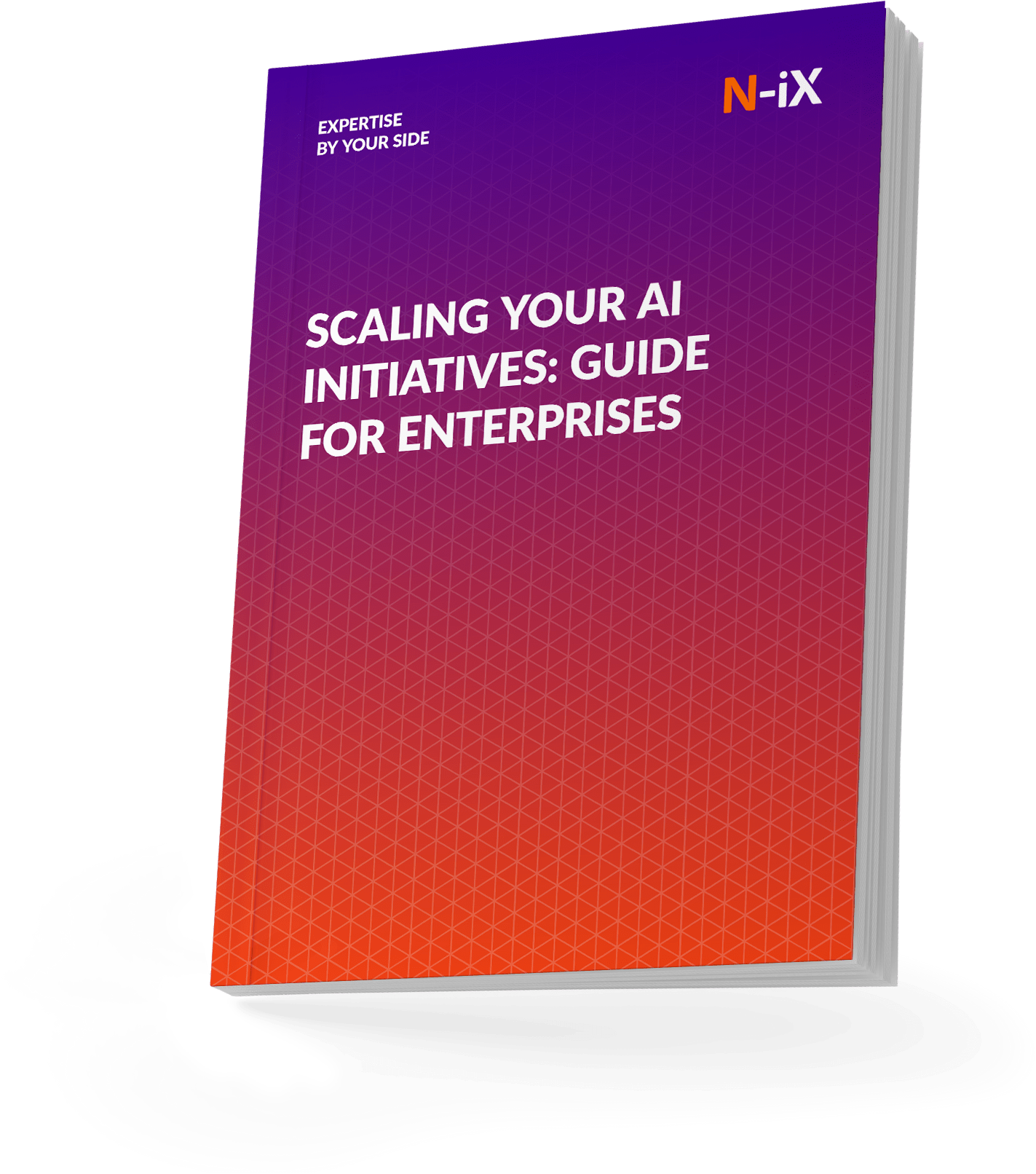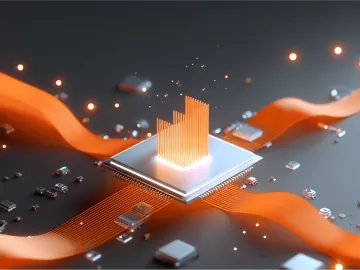Digital twins applications are experiencing significant market growth, with a projected compound annual growth rate (CAGR) of 50% from 2020 to 2030, reaching a valuation of $184.5B. The main driver behind this expansion is the substantial return on investment, with studies indicating that well-executed digital twin projects can yield a 6:1 return, according to the Institute of Digital Engineering. Companies that seek to tap into this growth partner with an experienced software engineering services provider. Let's explore the digital twins applications and key considerations across industries.
Digital twin model components
Digital twins are virtual replicas of physical assets that maintain continuous, bidirectional data flow between the real and digital worlds. By leveraging IoT, Big Data, AI, and ML, the applications extend beyond products to model processes, services, and even living systems. These tools ingest dynamic sensor and environmental data to power predictive analytics, simulations, and preventive maintenance. Unlike static models, digital twins evolve with AI‑driven insights, enabling real‑time optimization and data‑driven decision‑making. Digital twins applications deliver responsive, efficient tools essential for industries seeking seamless, informed operations.

A complete digital twin model comprises three main components: data, the model, and software. Data is the foundational element, as digital twins rely heavily on historical and real-time data collected from physical systems, including details about the system's operations and controllers. The model is the core of these tools, comprising theory-based and data-driven models. Theory models are built on the principles of physical systems, while data-driven models are trained using historical and real-time data through techniques such as AI and data processing. This iterative training process enables continuous self-learning and updating of the model for accuracy.

The software is the essential carrier that bridges physical systems and their digital representations. It incorporates the algorithms and code needed to create the digital twin models and ensures they function as intended. The software runs key functionalities such as representation, diagnosis, prediction, and decision-making. This enables the digital twin applications to provide optimized commands to the physical controller, enhancing the overall performance of the physical system.
Digital twins applications across industries
Digital twins applications have evolved into vital tools for many industries. They combine data integration, scenario simulations, and performance optimization by creating real-time digital replicas of physical assets and systems. Let's explore how industries such as manufacturing, healthcare, and construction leverage this innovative technology to transform processes and boost productivity.
Manufacturing
Digital twins applications first evolved in the manufacturing industry and have become a cornerstone of smart manufacturing and Industry 4.0. They are especially impactful in product life cycle management, addressing challenges like data isolation and duplication across design, manufacturing, and service stages. By enabling the testing and validation of models during the design phase and integrating real-time data on the shop floor, digital twins help streamline processes, optimize resource management, and improve manufacturing control. Companies like Siemens have recognized digital twins' significant role in unifying data across all stages of a product's life cycle, enhancing efficiency and predictive capabilities.
Practical applications of digital twins include General Electric's use for predictive maintenance across various sectors, such as power generation and oil and gas, yielding reported customer savings of $1.5B. In the automotive industry, Tesla employs this technology for every car manufactured, collecting real-time data to enable automatic adjustments and reconfiguration, which boosts operational accuracy and product performance. These examples show digital twins' transformative power in enhancing productivity, reducing costs, and optimizing manufacturing processes.
Read more: Digital twins in manufacturing: benefits, technologies and use cases
Healthcare
The healthcare industry first started implementing digital twins applications in predictive maintenance and device performance optimization but have since expanded significantly. GE Healthcare's 'Hospital of the Future Simulation Suite' exemplifies this evolution, using digital twins to model patient and staff behaviors, optimize patient flow, and improve resource allocation through data-driven what-if scenario testing. This approach has enhanced bed usage, surgical scheduling, and staff planning, supporting overall operational efficiency. Similarly, Siemens Healthineers, in partnership with Mater Private Hospital in Dublin, developed a digital twin for the hospital's radiology department to manage patient demand and resource use without expanding physical space, resulting in reduced waiting times, faster patient turnaround, and lower staffing costs.
Further, Siemens is advancing healthcare by creating digital models of human organs, aiming for a comprehensive digital twin of the entire human body. Starting with a heart model enhanced with deep learning for simulating physiological responses, such advancements support personalized and precision medicine. These digital twins are utilized for testing drug efficacy, personalized nutrition plans, and tailored treatment systems, offering healthcare practitioners a platform for trial-error experiments without risk to patients. This capability enables precise treatment planning and optimizing medical outcomes and healthcare processes.
Read more: Digital twins in healthcare: transforming patient care and operations
Supply chain
Supply Chain Digital Twins (SCDTs) address key challenges like disruption management and recovery by allowing real-time monitoring and proactive risk mitigation. Using data from IoT sensors, RFID systems, and third-party risk information, SCDTs feed AI algorithms to predict disruptions and simulate responses, aiding decision-makers in optimizing recovery strategies and maintaining network stability. This approach ensures that potential interruptions are anticipated and managed effectively.
Digital twins also tackle information asymmetry within remanufacturing supply chains, where data inconsistencies impede decision-making. Continuous, bidirectional data flow between the physical and digital realms helps synchronize and share real-time data across all enterprises in the chain. At the same time, adoption depends on enterprise readiness and data security concerns, advancements in IoT, Big Data, and cloud technology support seamless integration and implementation, enhancing overall supply chain transparency and efficiency.
Construction
Historically among the least digitized sectors, the construction industry now leverages digital twins technology to enable real-time, data-driven decision-making and process optimization. A notable example includes a digital twin-based decision support system for managing bulk silo dispatch and replenishment processes, addressing inefficiencies such as delayed material replenishment and lack of usage monitoring. Implementing digital twins in such scenarios has demonstrated potential cost savings and environmental benefits, including a 25% reduction in transportation costs and CO2 emissions through smarter logistics.
Additionally, these tools are applied in Structural Health Monitoring (SHM) to enhance infrastructure management, such as bridges. Digital twins improve data interoperability and lifecycle monitoring by integrating diverse data for analysis and interpretation. For example, the Netherlands' Rijkswaterstaat has pioneered using a digital twin for a tunnel project to simulate operations, anticipate incidents, and streamline stakeholder coordination, showcasing its practical benefits in large-scale construction projects.
Education
Digital twins serve as effective educational tools by providing high-fidelity virtual representations of physical processes, enabling students to engage in practical laboratory exercises that mirror real-world operations. This approach enhances learning by allowing students to apply theoretical knowledge through simulations without impacting actual systems. Professors supervise these sessions, ensuring students only transition to physical applications after demonstrating proficiency with the virtual models.
The concept of "cognitive digital twins" further elevates education by assisting individuals in managing their learning processes. The technology can identify knowledge gaps and suggest tailored learning paths by tracking educational activities such as courses, readings, and publications. This capability supports continuous skill development, helping learners stay current in an era of rapid information growth and knowledge obsolescence.
Smart cities
The advent of advanced sensing and communication technologies has paved the way for smart cities, where real-time data from IoT sensors and other sources monitors urban infrastructure and optimizes city services. Digital twins applications in smart cities enable cities to simulate and manage activities, aiding decision-makers in urban planning, mobility, energy use, and risk management. For instance, Herrenberg, Germany, uses a digital twin combining 3D models, urban mobility simulations, and collaborative data to test solutions for traffic and pollution, fostering public involvement in problem-solving.
Other notable examples include H2Porto in Portugal, a platform that manages the urban water cycle, using predictive analytics to improve service reliability and response times. Virtual Singapore creates a comprehensive 3D model incorporating data on infrastructure, traffic, and environmental conditions for planning and emergency management. Amsterdam's digital twin optimizes traffic flow near the ArenA stadium, leveraging 5G technology for real-time monitoring and improved visitor guidance. These examples illustrate how digital twins enhance urban efficiency, resilience, and citizen engagement.
Benefits of digital twins technology
Digital twins applications are a powerful tool for continuously uncovering hidden insights and strategic opportunities, as well as innovating with confidence. Here are the main benefits:
- Unifing data silos: Consolidate operational, environmental and historical data on a single platform for 360° visibility and seamless insights.
- Powering predictive maintenance: Leverage AI and ML to analyze sensor data, forecast failures before they happen, minimize downtime, and optimize maintenance schedules.
- Enabling what‑if simulations: Run virtual scenarios to evaluate decisions—whether in healthcare workflows or smart‑city planning—without risking real‑world disruptions.
- Boosting efficiency and safety: Automate repetitive tasks and permit remote operations in hazardous zones, freeing teams for creative problem‑solving and reducing incident rates.
- Driving data‑driven decisions: Combine IoT feeds with advanced analytics to fine‑tune processes, maximize resource utilization, and unlock substantial cost savings across industries.
Challenges of digital twins implementation
Digital twins offer great benefits, yet implementing them also entails navigating complex technical and organizational challenges. Let's understand the most common downsides:
- High computational costs: Advanced AI models demand GPU‑intensive processing, increasing infrastructure and operational expenses.
- Integration with legacy systems:Bridging outdated IT platforms with modern IoT architectures requires custom middleware and careful migration strategies.
- Robust data privacy and security requirements: Ensuring GDPR compliance and maintaining trust in AI workflows often involves federated learning and end‑to‑end encryption.
- Dependency on low‑latency connectivity: Real‑time, bidirectional data exchange mandates resilient network infrastructure and latency mitigation techniques.
- Data quality and volume requirements: Strategic sensor placement, rigorous validation, and scalable storage solutions are essential for handling IoT‑generated data.
- Lack of industry‑wide standardization: While ISO/DIS 23247‑1 and the Digital Twin Consortium offer guidance, broader standards across sectors are still evolving.
- Barriers for SMEs: Financial and technical demands can overwhelm smaller enterprises, though initiatives like TNO and DIGITbrain help lower adoption hurdles.
Despite these challenges, partnering with an experienced software development firm with deep data expertise helps navigate complexities and realize the full potential of digital twins applications.
Learn how to scale AI initiatives across your enterprise effectively – get the guide now!


Success!

Why partner with N-iX for your digital twins implementaion
N-iX has extensive experience in developing digital twin solutions. We have worked with various clients across different industries, including manufacturing, automotive, and healthcare, to create digital replicas of physical systems. With over 2,400 professionals on board and over 200 data experts, our experts specialize in integrating IoT devices, cloud computing, and advanced data analytics to create digital twins that can monitor system performance, predict future outcomes, and optimize operations.
Wrap-up
Once a sci‑fi concept, digital twins applications now create dynamic, real‑time replicas of physical assets—from individual devices to entire processes—powering Industry 4.0 across manufacturing, construction, healthcare and beyond. By uniting design, monitoring, analytics and forecasting in a single virtual model, they drive faster, data‑driven decisions. This evolution depends on robust IoT networks and advanced AI analytics, which bring major benefits—and their share of hurdles. As real‑time integration becomes indispensable, teaming up with seasoned digital‑transformation experts is essential to sidestep pitfalls and spark sustainable innovation and growth.
Have a question?
Speak to an expert




